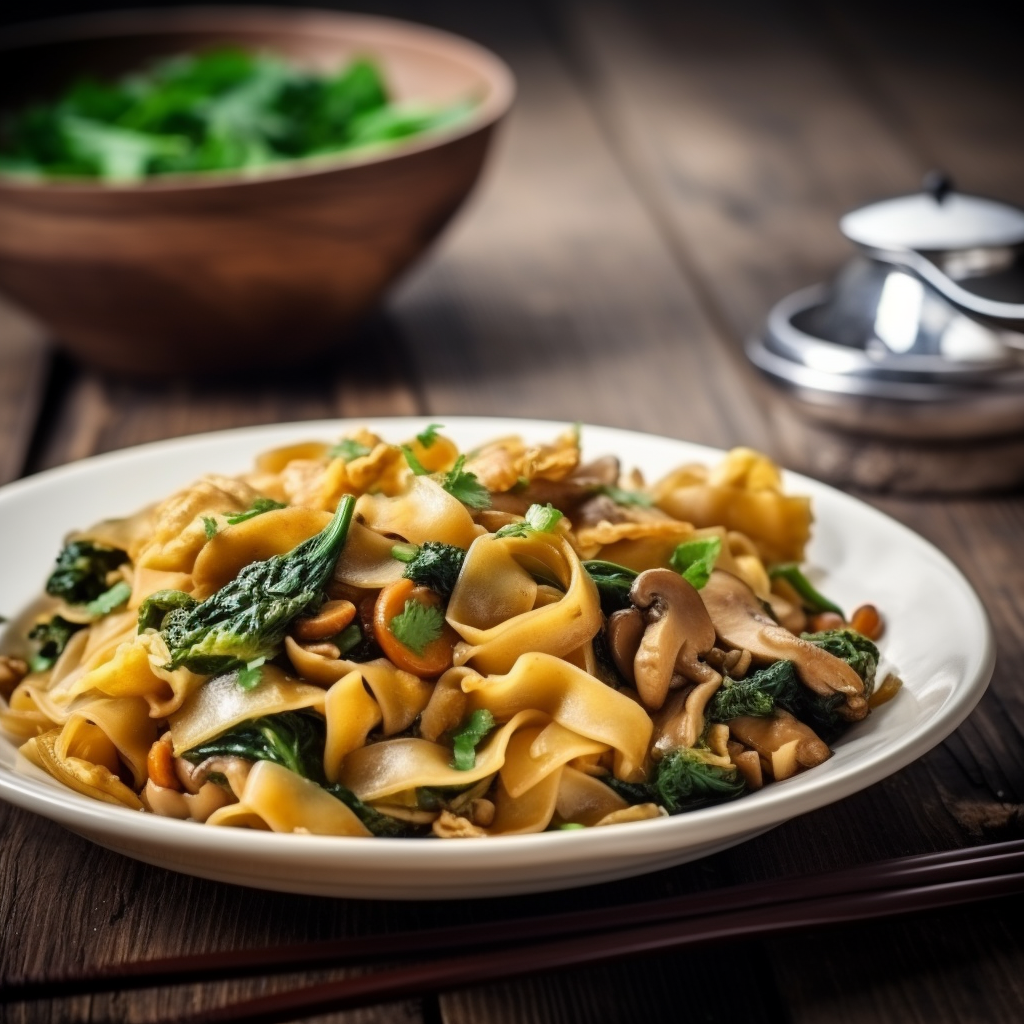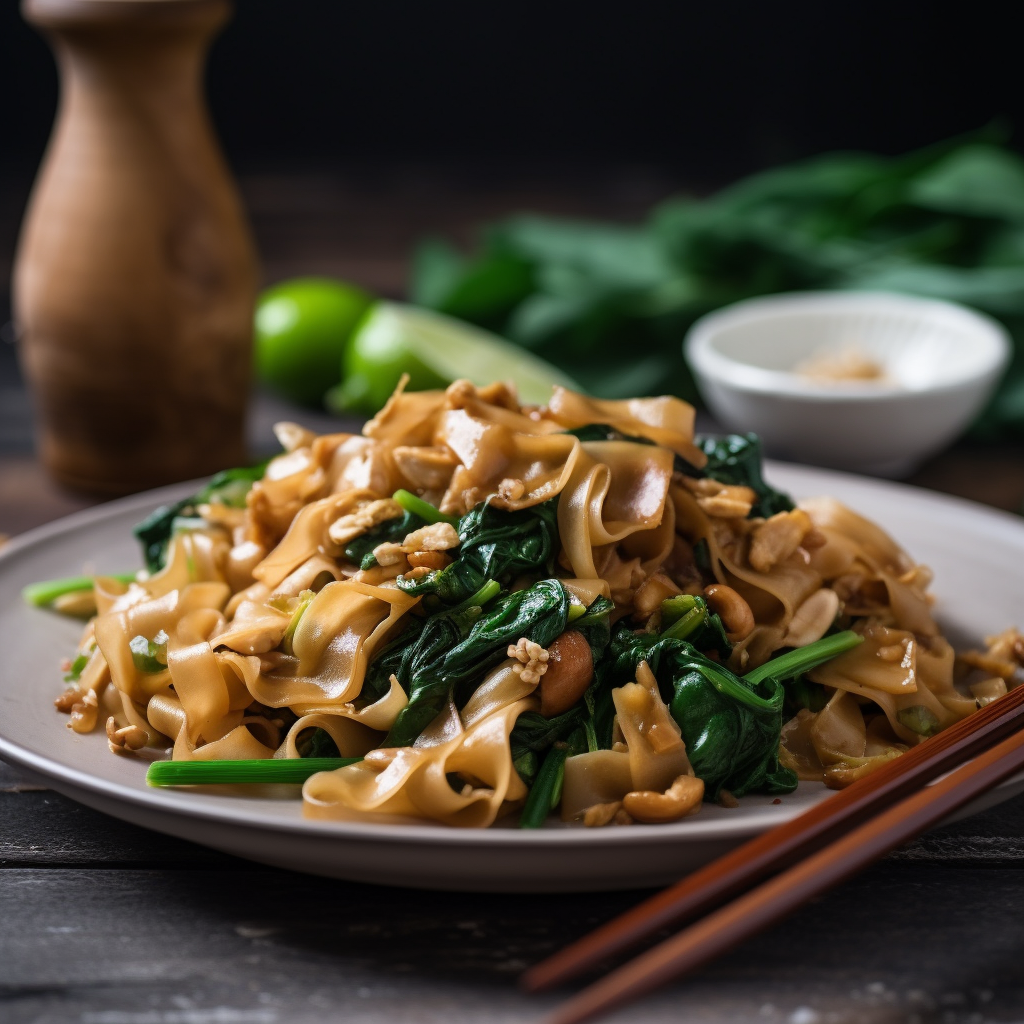This popular Thai dish brings together the comforting chewiness of wide rice noodles, the richness of eggs, the freshness of Chinese broccoli (gai lan), and your preferred protein, be it chicken, beef, shrimp, tofu, or pork.
Originating from the lively streets of Thailand, Pad See Ew is a beloved street food where skilled vendors masterfully stir-fry fresh wide rice noodles. The magic happens with the infusion of a delectable Pad See Ew sauce, crafted from the sweetness of Thai soy sauce, resulting in a flawless blend of sweet and savory flavors.
The name “pad see ew” itself offers a hint to its essence, translating to “fried with soy sauce” in Thai (pad for fried, and see ew for soy sauce). While it has become a staple in Thai noodle cuisine, the art of stir-frying noodles actually traces its roots back to China.
For those eager to recreate this Thai delicacy at home, don’t worry if fresh rice noodles are hard to come by – dried rice noodles work wonderfully too. A quick boil, just a minute or two shy of the instructions, is all it takes. The noodles will continue to cook to perfection as they dance in the wok. I personally tried and tested this recipe last month, and the results were nothing short of spectacular. It’s not just a recipe; it’s an experience that filled my kitchen with joy and my taste buds with pure delight. So, let’s roll up our sleeves and create some Pad See Ew magic together!
Overview: How To Make Pad See Ew Recipe?

Let’s make Pad See Ew – a flavorful Thai delight – with this quick and easy recipe that’s ready in just 15 minutes! Whether you’re a kitchen novice or a seasoned cook, this dish is a breeze to whip up.
First things first, let’s talk about ingredients. Grab some dried wide rice noodles, chicken (or your preferred protein), Chinese broccoli (gai lan), eggs, and a bit of avocado oil. Now, let’s not forget the star of the show – the Pad See Ew Sauce. It’s a magical blend of Thai sweet soy sauce, fish sauce, oyster sauce, dark soy sauce, white pepper powder, minced garlic, and a hint of sugar for that perfect balance.
Get started, boil the rice noodles for a couple of minutes less than instructed, as they’ll continue cooking during stir-frying. Rinse them under cold water and set them aside. Now, heat up your pan or wok, add a tablespoon of oil, and stir-fry your protein until it’s almost cooked. Create a little space, crack in the eggs, and give them a scramble.
Time to bring it all together – toss in the Chinese broccoli, the drained noodles, and our star, the Pad See Ew Sauce. Crank up the heat, and stir-fry like a pro until everything’s well-coated, and the sauce has worked its magic. For that extra touch, let the noodles caramelize and get a slight char, just like at your favorite Thai spot.
And there you have it – a plateful of Pad See Ew goodness! I personally tried this recipe, and trust me, the joy it brings to your taste buds is unbeatable. Serve it up hot, and get ready to savor a taste of Thai street food right in your own kitchen!
Try Such More Recipes!
- Butterfly Shrimp
- Homemade Grilled Octopus
- Poached Fish
- Lemon Pepper Tuna
- Bang Bang Chicken and Shrimp
Thai Dish Pad See Ew Recipe
Equipment
- 1 Large Skillet
- 1 Stirring Utensil
- 1 Cutting Board
- 1 Bowls
- 1 Garlic Press
Ingredients
FOR THE STEAK & MARINADE
- 8 ounces flank steak
- 1 tsp Thai black soy sauce
- 1 tsp vegetable oil
- 1 tsp cornstarch
FOR THE REST OF THE DISH:
- 1 tbsp oyster sauce
- 1/2 tsp sugar
- 2 tsp Thai soy sauce
- 1 tbsp Thai black soy sauce
- 1 tsp fish sauce
- Freshly ground white pepper
- 1 pound fresh wide rice noodles
- 3 Cups Chinese broccoli
- 2 large eggs
- 3 garlic sliced thinly
- 4 tsp vegetable oil
Instructions
- In a bowl, mix flank steak with Thai black soy sauce, vegetable oil, and cornstarch until completely coated. Set aside.
- In another bowl, combine oyster sauce, sugar, Thai soy sauce, Thai black soy sauce, fish sauce, and white pepper. Stir well to create a flavorful sauce.
- Ensure fresh rice noodles are at room temperature. If cold, quickly rinse under hot tap water to avoid clumping during stir-frying. Shake off excess water and set aside.
- For best results, use fresh wide rice noodles. Homemade rice noodles are also an option. If using dried noodles, halve the amount and undercook slightly. Toss with oil after draining to prevent sticking.
- Heat the wok on high until it smokes slightly. Spread 1 tablespoon of oil evenly. Sear the beef until 80% cooked, then return it to the marinade bowl.
- Add another tablespoon of oil to the wok. Stir in garlic, then quickly add Chinese broccoli, stir-frying for 20 seconds.
- Spread room temperature noodles in the wok. Pour the sauce over the noodles and gently mix with a scooping motion for about 20 seconds. Add the beef back to the wok.
- Push the mixture to one side, add a tablespoon of oil, and pour in beaten eggs. Scramble for a few seconds, breaking them into smaller pieces.
- Stir-fry the mixture until the noodles heat up evenly. Scrape the wok bottom to prevent sticking. Let the noodles caramelize slightly for that restaurant-style flavor.
- Continue cooking for 1 to 2 minutes until noodles are heated through. Serve hot and enjoy with Homemade Chili Oil or Chiu Chow Sauce on the side!
Notes
-
- Yeah, it’s a bit more effort, but trust me, cooking one portion at a time is totally worth it. This way, your noodles won’t get overcooked because too many of them trap too much steam in the wok.
- Don’t stack up too many noodles in the wok. It might seem easier, but it’s a trap! Too many noodles can lead to overcooking. Plus, you’ll miss out on that awesome toasty flavor we all love.
- If you spread them out and let them breathe, the noodles get a chance to char a bit. Trust me, that’s what gives them that amazing toasty flavor that makes this dish stand out.
- Picture this: noodles piled high trapping all that steam. Not cool! But, spread them out, let them char a bit, and you’ll get that iconic toasty flavor that makes this dish a winner.
- Taking the time to cook one portion at a time means no stress about overcooking. Your noodles get the attention they deserve, and you end up with that perfect balance of tenderness and toasty goodness.
Nutrition
Problems You Should Avoid!

- Broken Noodles:
- Issue: Aggressive stirring can break delicate fresh noodles.
- Solution: Opt for gentle flipping and tossing instead of vigorous stirring.
- Mushy Noodles:
- Issue: Overcrowding the pan traps moisture, leading to overcooked and mushy noodles.
- Solution: Cook one portion at a time to create space for charring and prevent excess moisture. Consider using a large wok for multiple portions.
- Off-Tasting Dish:
- Issue: Inaccurate ingredient ratios, particularly between sauce and noodles, can affect the taste.
- Solution: Measure ingredients precisely; eyeballing may result in blandness or excessive saltiness.
- Noodles Sticking to Pan:
- Issue: Fresh rice noodles tend to stick.
- Solution: Ensure a well-seasoned wok or use a nonstick pan to prevent sticking.
- Lack of Wok Hei (Smoky Flavor):
- Issue: Achieving the desired smoky wok flavor (wok hei) may be challenging with home equipment.
- Solution: Use a carbon steel wok on high heat for charring and smokiness. Avoid overcrowding the pan for better results.
Managing Leftovers!
- Avoid Overcooking: The key to managing leftovers of Pad See Ew is to avoid making more than you can consume in a day since rice noodles tend not to retain their original texture after reheating.
- Texture Consideration: Reheated rice noodles might not have the same appealing texture as freshly cooked ones. It’s essential to be mindful of this when planning leftovers.
- Storage Method: If you must store leftovers, use an airtight container to preserve the freshness and prevent odors from affecting the dish.
- Reheating Process: When reheating, opt for the microwave and ensure the noodles reach a piping-hot temperature. Rice noodles tend to become hard when cold and won’t regain their softness unless thoroughly heated.
- Time Limit: To maintain the quality of the dish, it’s recommended to keep Pad See Ew leftovers for no longer than one day. This ensures you enjoy the flavors and textures at their best.
Frequently Asked Questions (FAQs)
Q: Can I substitute other noodles for pad see ew?
A: Indeed! In Thailand, pad see ew is prepared with a variety of noodles. Check out my vermicelli pad see ew recipe, as it’s made with rice vermicelli, unlike the other popular one. I grew up eating pad see ew with egg noodles in Southern Thailand.
Q: How can I make a vegetarian pad see ew?
A: Tofu can be substituted for beef. To firm up the surface, use firm or extra firm tofu and fry them till golden. Finally, add them to the noodles. You can replace the fish sauce with soy sauce and use vegetarian oyster sauce (you can read more about vegetarian oyster sauce here).
Q: Can I use chicken instead of beef?
A: Yes. I would recommend chicken thighs, cut into bite-sized pieces, but chicken breast will also work if that’s what you prefer.

